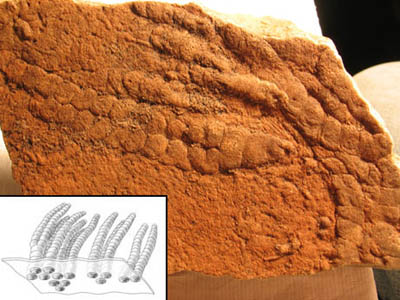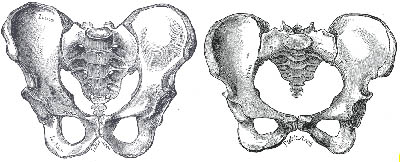Once upon a time in Earth’s history, all life reproduced through cloning. Be it binary fission, budding, spores, fragmentation, or parthenogenesis, every parent produced exact replicas of itself by itself. Everything was very stable, and evolution moved at a glacial pace, restricted to chance mutations with extremely rare beneficial effects.
Then, atleast 565 million years ago, a mutation arose within a species whereby individuals would recombine their DNA with other individuals of the species to produce offspring with a hybrid of their two genomes. This new evolutionary strategy was Sexual Reproduction.
 Funisia Fossils and Reconstruction (Earliest Known Species to Reproduce Sexually) credits: Droser lab |
Sexual reproduction carried a heavy cost to the species that used it. Individuals of the species would have to locate another member of their species and successfully reproduce, asexual reproduction was much more efficient and required much less energy in comparison. The advantage of sexual reproduction was that the perpetual recombination of genes resulted in increased genetic variation. The perpetual variety in genes increased the likelihood that some offspring would survive plagues, be they viral, bacterial, or parasitic. An asexual species, where all the members are clones, would all get wiped out by a single virus if it could kill just one of them. Sexual reproduction was so successful that nearly all complex life forms use it to reproduce today.
320 million years ago another mutation arose in mammals. Organisms carrying this genetic mutation were incapable of baring offspring themselves, and instead contributed their DNA to other members of the species capable of reproducing offspring. Today we call these mutants “males,” and they are identifiable via the Y Chromosome they carry, which is something of a genetic dead zone in human males, like myself and 50.3 percent of all other homo sapiens. Before the Y chromosome, species like reptiles and fish would become male or female depending on environmental factors.
As a result of many species evolving two genetically individuated genders, a sort of divergent evolution has occurred between the sexes. Depending on environmental factors, males of many species have evolved to grow larger in order to compete with other males. Females have evolved to become better at reproduction, becoming more nurturing both behaviorally and biologically to ensure the survival of their offspring. An additional evolutionary pressure was introduced, sexual selection.
In the animal kingdom, it appears the females are overwhelmingly in control of this aspect of evolution. Females fruit flies have bred their males to be better dancers. Females of many bird species make their males sing for their affections, an act that announces the male’s presence to predators as well. Most impressive is the way female peacocks have bred their males to grow ridiculously burdensome feathers, which require incredible nutritional resources to grow and make them easy prey for predators.
 This Fantastic Display Makes Him Easy Prey (An Albino Peacock) Credit: lightgazer |
Angler fish exhibit one of the world’s most dramatic examples of sexual dimorphism in order to adapt to the sparsely-populated abyss of the deep sea. Male angler fish are miniscule in comparison to their female counterparts. On the rare occurrence that a male encounters a female in the deep sea, he attaches himself to her, merging their circulatory systems. The male then proceeds to lose his eyes, mouth, and other organs until only his reproductive organs remain, supplying the female with sperm for reproduction and essentially turning her into a hermaphrodite.
 Female Angler Fish with Male Credit: Dr Tony Ayling |
Sexual Dimorphism in humans is a much more controversial subject. Who’s selecting who in human evolution?
While some traits are obviously a result of each gender’s role:
 Male (left) and Female (right) Pelvis Dimorphism Credit: Gray’s Anatomy |
It sounds as though human men and women have been selecting each other equally, when we consider some of the mate preferences that have been established:
Studies have also shown that humans have “subconscious” mate preferences (Thornhill and Gangestad 1996). Men generally prefer women with .7 hip-to-waist ratios, small jaws, plush lips, large eyes, and firm, symmetrical breasts. Women, on the other hand, generally have been shown to prefer broad foreheads, large jaws, strong chins, above average upper-body musculature, and a .9 hip-to-waist ratio (Cowley 1996).
There are a many other, less obvious differences of metabolism, subcutaneous fat, and antibodies, which do not settle the debate either way. One of the most hopeful findings in recent years is that men and women may have selected one another for intelligence. Our large brains require a great deal of nutrition to maintain, and can sometimes get us into as much trouble as they keep us out of.
Further Reading:
- Theories on the Evolution of Sexual Behavior.
- Examples of Sexual Selection in nature.
- Aphids switch between sexual and asexual reproduction depending on the season and food supplies. Aphids produced through sexual reproduction have wings in order to help them migrate to other locations where food might be more abundant.
Comments
10 responses to “The Evolutionary Battle of the Sexes”